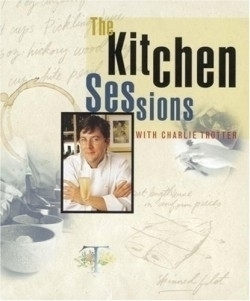The Kitchen Sessions
Trotter, whose townhouse restaurant in Chicago has continued to seduce both critics and patrons since its opening in 1987, has released another addition to his highly acclaimed collection of cookbooks. Ranging from the James Beard award winner, Charlie Trotter’s Seafood, to Charlie Trotter’s Desserts, Trotter’s cookbooks have been recognized for their unique melange of culinary tastes and traditions.
In keeping with Trotter’s personal cooking style The Kitchen Sessions emphasizes spontaneity. He recommends using the recipes as a guide for understanding the basic methods of preparation and various combinations of tastes and textures, but he also encourages the reader to be creative. Trotter claims that his own improvisational style of cooking was inspired in part by the great jazz artists of the 40s, 50s and 60s. Like jazz itself, Trotter draws from a diverse score of cultural traditions ranging from France to Thailand, India to South America, Italy to the American Southwest. Like musicians Miles Davis and Herbie Hancock, Trotter is continually recreating his recipes each time he plays them, hence the apt title, The Kitchen Sessions.
This new cookbook is composed with both harmony and surprise. The recipes present complex tastes and textures that stimulate the eye and nose as well as the palate. These qualities, combined with many elements of the exotic make for sensual cooking and feasting. Over 40 full-page color photographs give the reader a taste of the wonders of food presentation. Highlights include grilled pork chops with pickled onions and fig balsamic sauce; seared tuna with fennel broth, herbed saetzle and sundried tomatoes; pumpkin tortellini with brown butter vinaigrette and burnt caramel-arborio rice creme brulee. Approximately 30% of the book is devoted to fish and seafood, 30% to meats and poultry, and the remainder is divided up between soups, salads, pasta and desserts. In addition each main dish includes the recipes for appropriate accompaniments. Vegetarian dishes and cooking options are present but not prevalent.
Each recipe receives a brief description of the key elements that contribute to the dish as well as excellent wine notes recommending both a complementary style of wine and a particular winemaker. Unfortunately, the specific wines Trotter suggests are virtually unavailable to most wine dealers and extremely expensive to-boot. Readers will do well to look for the style of wine rather than the maker.
The recipes themselves are clear and easy to follow for the moderately experienced cook. More than 50 diagrams provide additional ease. The reader is expected to have an understanding of certain basic French terms like julienne, brunoise, chiffonade and creme fraiche. Many recipes can be prepared fairly quickly (20-45 minutes), others can be prepared a few days in advance, but most require at least an hour of prep work. On the down side many ingredients are not readily available at the supermarket, and may require a bit of research. Ingredients such as star anise, lemongrass, daikon, fenugreek, nori, duck, pheasant, and boar chops will be found in gourmet stores, meat markets, or not at all. Fortunately, Trotter recommends substitutions for many items like lobster for pheasant and lamb or pork chops in place of wild boar. In addition, the reader will find the extra effort in locating the more elusive herbs and vegetables well worth the effort. The effect is a table that will stimulate and seduce even the most conservative palate.
Reviewed by
Jennifer Sperry
Disclosure: This article is not an endorsement, but a review. The publisher of this book provided free copies of the book to have their book reviewed by a professional reviewer. No fee was paid by the publisher for this review. Foreword Reviews only recommends books that we love. Foreword Magazine, Inc. is disclosing this in accordance with the Federal Trade Commission’s 16 CFR, Part 255.

